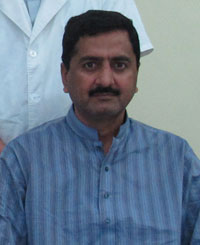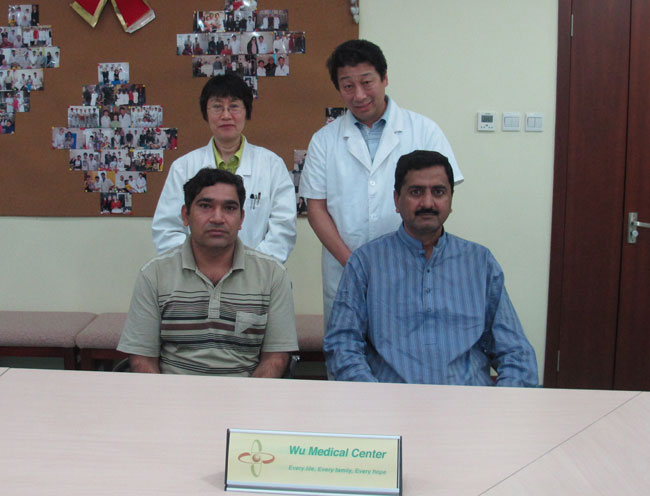Muhammad Imtiaz - ALS (Pakistan) Posted on October 17, 2014
Name: Muhammad Imtiaz 
Sex: Male
Country: Pakistan
Age:47 years
Diagnoses: 1.Amyotrophic lateral sclerosis 2. Type 2 diabetes 3. Sleep apnea syndrome 4. Hypertension level 1 5. Post bypass surgery
Date: September15, 2014
Days Admitted to Hospital: 18 days
Before treatment:
The patient suffered from weakness of left limbs 1 year ago. He also suffered from muscle atrophy in left hand and fingers. The EMG and related examination showed he suffered from ALS. He took vitamin and Riluzole for treatment. But the disease still aggravated. He suffered obvious muscle atrophy. His right hand and both lower limbs suffered weakness too. He always felt tired and the activity intolerance was reduced obviously. He suffered from breathing difficulty. He still could take care of himself before the treatment.
The patient's weight reduced by 12Kg from the onset of disease. His spirit was stable. His emotion was stable. The diet and sleep were normal. The defecation and urine were normal. There was no cough when he drinks.
Admission PE:
Bp: 110/79mmHg; Hr: 110/min, temperature 36.5 deg. Br: 20/min. Height: 181cm, weight: 79Kg. The patient's nutrition were normal. The body type was normal. His skin and mucosa were normal, with no yellow stains or petechia. The lung's movement was weak and mainly was abdominal respiration. The respiratory sounds in both lungs were clear, with no obvious rales. The respiratory sounds in both lungs' at bottom was low. Through auscultation: the cardiac sound was low and blunt. The rhythm of his heartbeat was normal, with no obvious murmur in the valves. His abdomen was soft, with no pressing pain or rebound tenderness in the abdomen. The liver or spleen under the ribs were not enlarged. There was no swelling in both lower limbs.
Nervous System Examination:
Muhammad Imtiaz was alert and his spirit was slightly weak. His memory, calculation abilities and orientation were all normal. Both pupils were equal in size, the diameter was 3mms. Both eyeballs could move flexibly and the pupils reacted normally to light stimulus. The convergence ability of both eyes was poor. The forehead wrinkle pattern was symmetrical. The bilateral nasolabial sulcus was equal in depth. He was able to close his eyes with ease. The tongue was at the center of his oral cavity. The teeth was shown without deflection. There was no obvious atrophy in tongue. The movement of tongue was flexible to each side. He had strong muscle to raise his soft palate. The uvula was in the center of oral cavity. His neck was soft. He could turn his head to the left side and right side normally. The muscle strength to shrug left shoulder was strong. The muscle strength to shrug right shoulder was slightly weak. The muscle strength of left upper limb was at level 4. The hold power of left hand was at level 3. The muscle strength of left forefinger and middle finger was at level 3-. The muscle strength of right upper limb was at level 5-. The hold power of right hand was at level 5. The muscle strength of both lower limbs was at level 4-. The muscle tone of his four limbs was normal. The tendon reflex of his four limbs was normal. There was fasciculation in both upper limbs. There was moderate atrophy in his left hand fingers muscle, left upper limb's distal muscle and left shoulder outer muscle. There was mild atrophy in his right hand fingers muscle, right upper limb's distal muscle and right shoulder outer muscle. The abdominal reflexes disappeared. Bilateral Babinski sign was neutral. The deep sensation and shallow sensation, using primary measures, were normal. His right hand was able to finish the finger - to - nose test, coordinate movement test and the rapid rotation test in a stable manner. But his left hand was unable to do all the above test. He did the heel-knee-shin test in a stable manner. There were no signs of meningeal irritation.
Treatment:
We initially gave Muhammad Imtiaz a complete examination. The patient received treatment for nerve regeneration and to activate stem cells in vivo. He received treatment to improve his blood circulation in order to increase the blood supply to the damaged neurons and to nourish them. He also received treatment for protection of organ function and also for the control of blood sugar. At the same time, he received Non-invasive ventilator to increase the oxygen supply. The ventilator mode was ST, Br: 12/min, IPAP 15cmH20, EPAP 6 cmH20. This was accompanied by daily physical rehabilitation training.
Post treatment:
The patient's condition has improved. The hold power of left hand has reached level 4-. The muscle strength of left upper limb is at level 4+. The muscle strength of right upper limb has been restored to level 5. The muscle volume of both hands (thenar) and left scapular region has increased. The endurance of whole body has enhanced obviously. The movement of thorax has increased when he is breathing. At present, the breath sounds in both lung's bottom are clearer than before. The sleep apnea at night has been alleviated obviously.

